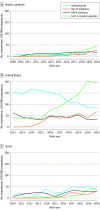Safety of GLP-1 Receptor Agonists and Other Second-Line Antidiabetics in Early Pregnancy
- PMID: 38079178
- PMCID: PMC10714281
- DOI: 10.1001/jamainternmed.2023.6663
Safety of GLP-1 Receptor Agonists and Other Second-Line Antidiabetics in Early Pregnancy
Abstract
Importance: Increasing use of second-line noninsulin antidiabetic medication (ADM) in pregnant individuals with type 2 diabetes (T2D) may result in fetal exposure, but their teratogenic risk is unknown.
Objective: To evaluate periconceptional use of second-line noninsulin ADMs and whether it is associated with increased risk of major congenital malformations (MCMs) in the infant.
Design, setting, and participants: This observational population-based cohort study used data from 4 Nordic countries (2009-2020), the US MarketScan Database (2012-2021), and the Israeli Maccabi Health Services database (2009-2020). Pregnant women with T2D were identified and their live-born infants were followed until up to 1 year after birth.
Exposure: Periconceptional exposure was defined as 1 or more prescription fill of sulfonylureas, dipeptidyl peptidase 4 (DPP-4) inhibitors, glucagon-like peptide 1 (GLP-1) receptor agonists, and sodium-glucose cotransporter 2 (SGLT2) inhibitors, or insulin (active comparator) from 90 days before pregnancy to end of first trimester.
Main outcomes and measures: Relative risks (RRs) and 95% CIs for MCMs were estimated using log-binomial regression models, adjusting for key confounders in each cohort and meta-analyzed.
Results: Periconceptional exposure to second-line noninsulin ADMs differed between countries (32, 295, and 73 per 100 000 pregnancies in the Nordics, US, and Israel, respectively), and increased over the study period, especially in the US. The standardized prevalence of MCMs was 3.7% in all infants (n = 3 514 865), 5.3% in the infants born to women with T2D (n = 51 826), and among infants exposed to sulfonylureas was 9.7% (n = 1362); DPP-4 inhibitors, 6.1% (n = 687); GLP-1 receptor agonists, 8.3% (n = 938); SGLT2 inhibitors, 7.0% (n = 335); and insulin, 7.8% (n = 5078). Compared with insulin, adjusted RRs for MCMs were 1.18 (95% CI, 0.94-1.48), 0.83 (95% CI, 0.64-1.06), 0.95 (95% CI, 0.72-1.26), and 0.98 (95% CI, 0.65-1.46) for infants exposed to sulfonylureas, DPP-4 inhibitors, GLP-1 receptor agonists, and SGLT2 inhibitors, respectively.
Conclusions and relevance: Use of second-line noninsulin ADMs is rapidly increasing for treatment of T2D and other indications, resulting in an increasing number of exposed pregnancies. Although some estimates were imprecise, results did not indicate a large increased risk of MCMs above the risk conferred by maternal T2D requiring second-line treatment. Although reassuring, confirmation from other studies is needed, and continuous monitoring will provide more precise estimates as data accumulate.
Conflict of interest statement
Figures


Comment in
-
Promising Safety Profile of Noninsulin Medications for Type 2 Diabetes in Early Pregnancy.JAMA Intern Med. 2024 Feb 1;184(2):152-153. doi: 10.1001/jamainternmed.2023.8422. JAMA Intern Med. 2024. PMID: 38315209 No abstract available.
-
In T2DM, periconceptional, noninsulin, second-line antidiabetes medications were not linked to major congenital malformations vs. insulin.Ann Intern Med. 2024 Apr;177(4):JC47. doi: 10.7326/J24-0015. Epub 2024 Apr 2. Ann Intern Med. 2024. PMID: 38560907
References
Publication types
MeSH terms
Substances
Grants and funding
LinkOut - more resources
Full Text Sources
Medical
Miscellaneous

